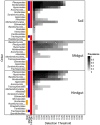Larvae of an invasive scarab increase greenhouse gas emissions from soils and recruit gut mycobiota involved in C and N transformations
- PMID: 37025631
- PMCID: PMC10072269
- DOI: 10.3389/fmicb.2023.1102523
Larvae of an invasive scarab increase greenhouse gas emissions from soils and recruit gut mycobiota involved in C and N transformations
Abstract
Background: Soil-derived prokaryotic gut communities of the Japanese beetle Popillia japonica Newman (JB) larval gut include heterotrophic, ammonia-oxidizing, and methanogenic microbes potentially capable of promoting greenhouse gas (GHG) emissions. However, no research has directly explored GHG emissions or the eukaryotic microbiota associated with the larval gut of this invasive species. In particular, fungi are frequently associated with the insect gut where they produce digestive enzymes and aid in nutrient acquisition. Using a series of laboratory and field experiments, this study aimed to (1) assess the impact of JB larvae on soil GHG emissions; (2) characterize gut mycobiota associated with these larvae; and (3) examine how soil biological and physicochemical characteristics influence variation in both GHG emissions and the composition of larval gut mycobiota.
Methods: Manipulative laboratory experiments consisted of microcosms containing increasing densities of JB larvae alone or in clean (uninfested) soil. Field experiments included 10 locations across Indiana and Wisconsin where gas samples from soils, as well as JB and their associated soil were collected to analyze soil GHG emissions, and mycobiota (ITS survey), respectively.
Results: In laboratory trials, emission rates of CO2, CH4, and N2O from infested soil were ≥ 6.3× higher per larva than emissions from JB larvae alone whereas CO2 emission rates from soils previously infested by JB larvae were 1.3× higher than emissions from JB larvae alone. In the field, JB larval density was a significant predictor of CO2 emissions from infested soils, and both CO2 and CH4 emissions were higher in previously infested soils. We found that geographic location had the greatest influence on variation in larval gut mycobiota, although the effects of compartment (i.e., soil, midgut and hindgut) were also significant. There was substantial overlap in the composition and prevalence of the core fungal mycobiota across compartments with prominent fungal taxa being associated with cellulose degradation and prokaryotic methane production/consumption. Soil physicochemical characteristics such as organic matter, cation exchange capacity, sand, and water holding capacity, were also correlated with both soil GHG emission, and fungal a-diversity within the JB larval gut. Conclusions: Results indicate JB larvae promote GHG emissions from the soil directly through metabolic activities, and indirectly by creating soil conditions that favor GHG-associated microbial activity. Fungal communities associated with the JB larval gut are primarily influenced by adaptation to local soils, with many prominent members of that consortium potentially contributing to C and N transformations capable of influencing GHG emissions from infested soil.
Keywords: Japanese beetles; carbon dioxide; core mycobiota; fungal ITS1; methane; nitrous oxide.
Copyright © 2023 Avila-Arias, Turco, Scharf, Groves and Richmond.
Conflict of interest statement
The authors declare that the research was conducted in the absence of any commercial or financial relationships that could be construed as a potential conflict of interest.
Figures






Similar articles
-
Metagenomic analysis reveals methanogenic and other archaeal genes in the digestive tract of invasive Japanese beetle larvae and associated soil.Front Microbiol. 2025 Jul 25;16:1609893. doi: 10.3389/fmicb.2025.1609893. eCollection 2025. Front Microbiol. 2025. PMID: 40785790 Free PMC article.
-
Soil Environments Influence Gut Prokaryotic Communities in the Larvae of the Invasive Japanese Beetle Popillia japonica Newman.Front Microbiol. 2022 Apr 27;13:854513. doi: 10.3389/fmicb.2022.854513. eCollection 2022. Front Microbiol. 2022. PMID: 35572692 Free PMC article.
-
First field estimation of greenhouse gas release from European soil-dwelling Scarabaeidae larvae targeting the genus Melolontha.PLoS One. 2020 Aug 26;15(8):e0238057. doi: 10.1371/journal.pone.0238057. eCollection 2020. PLoS One. 2020. PMID: 32845917 Free PMC article.
-
Patterns and environmental drivers of greenhouse gas fluxes in the coastal wetlands of China: A systematic review and synthesis.Environ Res. 2020 Jul;186:109576. doi: 10.1016/j.envres.2020.109576. Epub 2020 Apr 25. Environ Res. 2020. PMID: 32361080
-
Mitigation of global greenhouse gas emissions from waste: conclusions and strategies from the Intergovernmental Panel on Climate Change (IPCC) Fourth Assessment Report. Working Group III (Mitigation).Waste Manag Res. 2008 Feb;26(1):11-32. doi: 10.1177/0734242X07088433. Waste Manag Res. 2008. PMID: 18338699 Review.
Cited by
-
Recent advances in gut microbiota and thyroid disease: pathogenesis and therapeutics in autoimmune, neoplastic, and nodular conditions.Front Cell Infect Microbiol. 2024 Dec 24;14:1465928. doi: 10.3389/fcimb.2024.1465928. eCollection 2024. Front Cell Infect Microbiol. 2024. PMID: 39776440 Free PMC article. Review.
-
Metagenomic analysis reveals methanogenic and other archaeal genes in the digestive tract of invasive Japanese beetle larvae and associated soil.Front Microbiol. 2025 Jul 25;16:1609893. doi: 10.3389/fmicb.2025.1609893. eCollection 2025. Front Microbiol. 2025. PMID: 40785790 Free PMC article.
References
-
- Abercrombie W. F. (1936). Studies on cell number and the progression factor in the growth of Japanese beetle larvae (Popillia japonica Newman). J. Morphol. 59, 91–112. doi: 10.1002/jmor.1050590105 - DOI
-
- Álvaro-Fuentes J., Cantero-Martínez C., López M. V., Arrúe J. L. (2007). Soil carbon dioxide fluxes following tillage in semiarid Mediterranean agroecosystems. Soil Tillage Res. 96, 331–341. doi: 10.1016/j.still.2007.08.003 - DOI
-
- Anderson M. J. (2001). A new method for non-parametric multivariate analysis of variance. Austral Ecol. 26, 32–46. doi: 10.1111/j.1442-9993.2001.01070.pp.x - DOI
-
- Anderson C. R., Peterson M. E., Frampton R. A., Bulman S. R., Keenan S., Curtin D. (2018). Rapid increases in soil pH solubilise organic matter, dramatically increase denitrification potential and strongly stimulate microorganisms from the Firmicutes phylum. PeerJ 6:e6090. doi: 10.7717/peerj.6090, PMID: - DOI - PMC - PubMed
LinkOut - more resources
Full Text Sources

